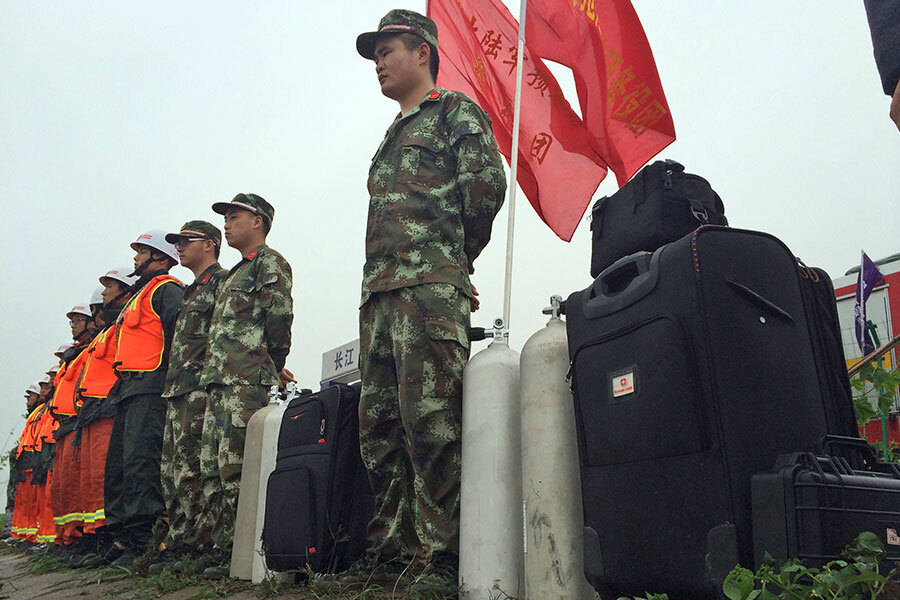Yangtze River ship sinks in China: More than 450 on board
| Jianli, China
Divers on Tuesday pulled three people alive from inside a capsized cruise ship and searched for other survivors, state media said, giving some small hope to an apparently massive tragedy with well over 400 people still missing on the Yangtze River.
The tally of those brought to safety stood at 15 and at least five people were confirmed dead after the ship capsized during a storm Monday night with 458 people aboard, the official Xinhua News Agency said. The cruise was from Nanjing to the southwestern city of Chongqing, and many of those aboard were elderly.
Some of the survivors swam ashore, but others were rescued more than 12 hours after the ship went down, after search teams climbed aboard the upside-down hull and heard people calling out from within.
Footage from state broadcaster CCTV showed rescuers in orange life vests climbing on the upside-down hull, with one of them lying down tapping a hammer and listening for a response, then gesturing downward.
Divers pulled out a 65-year-old woman and, later, two men who had been trapped, CCTV said. It said additional people had been found and were being rescued, but did not say whether they were still inside the overturned hull.
Other survivors include the ship's captain and the chief engineer.
The overturned ship had drifted about 3 kilometers (almost 2 miles) downstream before coming to rest close to the river shore, where choppy waters made the rescue difficult. The location is about 180 kilometers (110 miles) west of the Hubei provincial capital of Wuhan.
The fact that the capsized ship drifted downstream was a good sign for rescuers because it meant there was enough air inside to give it buoyancy, and could mean there are enough air pockets for survivors to breathe, said Chi-Mo Park, a professor of naval architecture and ocean engineering at South Korea's Ulsan University.
"It all depends how much space there is inside the vessel," Park said.
Xinhua cited the captain and the chief engineer as saying the ship sank quickly after being caught in a cyclone. CCTV said the two were under police custody. The Communist Party-run People's Daily said the ship sank within two minutes.
CCTV said the four-level ship had been carrying 406 Chinese passengers, five travel agency employees and 47 crew members. The broadcaster said most of the passengers were 50 to 80 years of age.
Many of the ship's passengers started out in Shanghai, taking a bus to Nanjing for the departure to Chongqing. Relatives of passengers gathered in Shanghai at a travel agency that had booked many of the trips, and they later headed to a government office to try to get more information about the accident.
Huang Yan, 49, an accountant in Shanghai, wept as she told a reporter that she believes that her husband, 49, and his father, who is in his 70s, were aboard the boat. But she said she couldn't be sure because she hadn't seen an official passenger list yet.
"Why did the captain leave the ship while the passengers were still missing?" Huang shouted. "We want the government to release the name list to see who was on the boat."
A group of about a dozen retirees from a Shanghai bus company were on the trip, said a woman who identified herself only by her surname, Chen. Among them, she said, were her elder sister and her elder sister's husband, both 60, and their 6-year-old granddaughter.
"This group has traveled together a lot, but only on short trips. This is the first time they traveled for a long trip," Chen said.
The ship sank in the Damazhou waterway section, where the river is 15 meters (50 feet) deep. The Yangtze is the world's third-longest river and sometimes floods during the summer monsoon season.
Several rescue ships were searching the waters, and divers had been deployed. The broadcaster said rescue personnel were trying to determine whether they could right the sunken ship.
More than 50 boats and 3,000 people were involved in search efforts.
The Eastern Star measured 251 feet long (76.5 meters) and 36 feet wide (11 meters) and was capable of carrying a maximum of 534 people, CCTV reported. It is owned by the Chongqing Eastern Shipping Corp., which focuses on tourism routes in the popular Three Gorges river canyon region. The company could not be reached for comment.
CCTV reported that 6 inches (150 millimeters) of rain had fallen in the region over the past 24 hours. Local media reported winds reached 80 mph (130 kph) during the accident.
Chinese Premier Li Keqiang is reported to be traveling to the accident site. Xinhua reported that President Xi Jinping had ordered a work team of the State Council, the country's Cabinet, to rush to the site to guide the rescue work.
___
AP writers Jack Chang and Ian Mader and news assistant Yu Bing in Beijing, news assistant Fu Ting in Shanghai, and writer Tong-hyung Kim in Seoul, South Korea, contributed to this report.
___
This story has been corrected to show that four survivors were still waiting to be rescued.
Copyright 2015 The Associated Press. All rights reserved. This material may not be published, broadcast, rewritten or redistributed.






